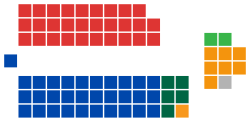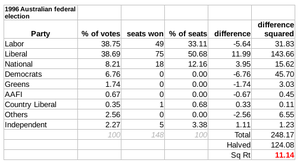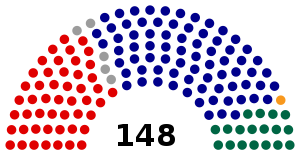The 1996 Australian federal election was held to determine the members of the 38th Parliament of Australia. It was held on 2 March 1996. All 148 seats of the House of Representatives and 40 seats of the 76-seat Senate were up for election. The centre-right Liberal/National Coalition led by Opposition Leader John Howard of the Liberal Party and coalition partner Tim Fischer of the National Party defeated the incumbent centre-left Australian Labor Party government led by Prime Minister Paul Keating in a landslide victory. The Coalition won 94 seats in the House of Representatives, which is the largest number of seats held by a federal government to date, and only the second time a party had won over 90 seats at a federal election.
| |||||||||||||||||||||||||||||||||||||||||||
All 148 seats in the House of Representatives 75 seats were needed for a majority in the House 40 (of the 76) seats in the Senate | |||||||||||||||||||||||||||||||||||||||||||
|---|---|---|---|---|---|---|---|---|---|---|---|---|---|---|---|---|---|---|---|---|---|---|---|---|---|---|---|---|---|---|---|---|---|---|---|---|---|---|---|---|---|---|---|
| Registered | 11,740,568 | ||||||||||||||||||||||||||||||||||||||||||
| Turnout | 11,244,017 (95.77%) ( | ||||||||||||||||||||||||||||||||||||||||||
| |||||||||||||||||||||||||||||||||||||||||||
 Results by division for the House of Representatives, shaded by winning party's margin of victory. | |||||||||||||||||||||||||||||||||||||||||||
| |||||||||||||||||||||||||||||||||||||||||||
The election marked the end of the five-term, 13-year Hawke-Keating Government that began in 1983. Howard was sworn in as the new Prime Minister of Australia on 11 March 1996, along with the First Howard Ministry. This election was the start of the 11-year Howard Government; the Labor party would spend this period in opposition and would not return to government until the 2007 election.
This was the first federal election that future Prime Minister Tony Abbott contested as a member of parliament, having entered parliament at the 1994 Warringah by-election. Future Prime Minister Anthony Albanese and future opposition leader Brendan Nelson also entered parliament at this election.
Future Prime Ministers Kevin Rudd and Julia Gillard were unsuccessful candidates for the House of Representatives and Senate respectively at this election and would eventually be elected to the House of Representatives at the next election in 1998.
Howard became the first Liberal leader to win an election from opposition since Robert Menzies in 1949. (Malcolm Fraser was caretaker prime minister in the 1975 election.) The victory also saw the Liberal Party gain enough seats to not require the support of the National Party, though John Howard opted to stay in the Coalition. As of 2023 this is the last time the Liberal Party has won an overall majority of seats in federal parliament and also the last when both major party leaders born prior to 1946, the first year of the Post-war era.
Background
editJohn Howard, who had previously led the Liberal Party from 1985 to 1989, returned to the leadership in January 1995 following the party's disastrous eight months under the leadership of Alexander Downer. Downer and Peter Costello had succeeded John Hewson and Michael Wooldridge early in 1994 and were touted as the leaders of the new-generation Liberals. In the end, the party opted for the seasoned Howard, perhaps an acknowledgment that he was the only one left standing after a decade of party infighting.
Howard approached the campaign with a determination to present as small a target as possible. Throughout 1995 he refused to detail specific policy proposals, focusing the Coalition's attacks mainly on the longevity and governing record of the Labor government. By 1996, however, it was clear that the electorate had tired of Labor and in particular of Paul Keating. The line "The recession we had to have" resonated with deadly force throughout the electorate. Although Keating's big-picture approach to republicanism, reconciliation with Australia's Indigenous peoples and engagement with Asia galvanised support within Labor's urban constituencies, Howard was able to attract support amongst disaffected mainstream Australians, uniting middle-class suburban residents with traditionally Labor-voting blue-collar workers. He also promised to retain Medicare and hold a constitutional convention to decide whether Australia would become a republic.
The election-eve Newspoll reported the Liberal/National Coalition held an estimated 53.5 percent two-party-preferred vote.[1]
Results
editHouse of Representatives results
edit
Coalition
Liberal (75)
National (18)
CLP (1)
Opposition (49)
Labor (49)
Crossbench (5)
Independent (5)
| Party | Votes | % | Swing | Seats | Change | |||
|---|---|---|---|---|---|---|---|---|
| Liberal | 4,210,689 | 38.69 | +1.92 | 75 |  26 26 | |||
| National | 893,170 | 8.21 | +1.04 | 18 |  2 2 | |||
| Country Liberal | 38,302 | 0.35 | +0.02 | 1 |  1 1 | |||
| Liberal/National Coalition | 5,142,161 | 47.25 | +2.98 | 94 |  29 29 | |||
| Labor | 4,217,765 | 38.75 | −6.17 | 49 |  31 31 | |||
| Democrats | 735,848 | 6.76 | +3.01 | |||||
| Greens [a] | 317,654 | 2.92 | +1.09 | |||||
| Independents | 262,420 | 2.41 | −0.73 | 5 |  3 3 | |||
| Others | 208,004 | 1.91 | +1.05 | |||||
| Total | 10,883,852 | 148 |  1 1 | |||||
| Two-party-preferred vote | ||||||||
| Liberal–National coalition | Win | 53.63 | +5.07 | 94 |  29 29 | |||
| Labor | 46.37 | −5.07 | 49 |  31 31 | ||||
Senate results
edit
Coalition
Liberal (31)
National (5)
CLP (1)
Opposition (29)
Labor (29)
Crossbench (10)
Democrats (7)
Greens (2)
Independent (1)
| Party | Votes | % | Swing | Seats won | Seats held | Change | ||
|---|---|---|---|---|---|---|---|---|
| Liberal–National joint ticket | 2,669,377 | 24.49 | +0.09 | 6 | N/A | |||
| Liberal | 1,770,486 | 16.24 | +0.65 | 12 | 31 |  2 2 | ||
| National | 312,769 | 2.87 | +0.15 | 1 | 5 |  1 1 | ||
| Country Liberal | 40,050 | 0.37 | +0.04 | 1 | 1 |  | ||
| Liberal–National coalition | 4,792,682 | 43.97 | +0.92 | 20 | 37 |  1 1 | ||
| Labor | 3,940,150 | 36.15 | −7.35 | 14 | 29 |  1 1 | ||
| Democrats | 1,179,357 | 10.82 | +5.51 | 5 | 7 |  | ||
| Greens [b] | 345,513 | 3.17 | +0.67 | 1 | 2 |  | ||
| Others [c] | 641,335 | 5.88 | 0 | 1 |  | |||
| Total | 10,899,037 | 40 | 76 | |||||
| Invalid/blank votes | 395,442 | 3.5 | ||||||
| Turnout | 11,294,479 | 96.2 | ||||||
| Registered voters | 11,740,568 | |||||||
| Source: Federal Elections 1996 | ||||||||
House of Reps preference flows
edit- The Democrats contested 138 electorates with preferences slightly favouring Labor (54.02%)
- The Greens contested 102 electorates with preferences favouring Labor (67.10%)
Seats changing hands
edit- *Figure is Liberal against Nationals.
- **Figure is a swing compared to Liberal vote at the last election.
Analysis
editOverall the coalition won 29 seats from Labor while the ALP won 4 seats from the Liberals. These 4 seats were Canberra and Namadgi in the ACT and Isaacs and Bruce in Victoria. The ACT seats, which had been won by the Liberals in a by-election, fell to Labor due to a strong return to the ALP in a traditional Labor town by public servants fearing conservative cuts. The division of Brendan Smyth's seat of Canberra into the two new (of the three) ACT seats limited his campaign to the southernmost Tuggeranong seat of Namadgi where the ACT Labor right wing stood former MLA Annette Ellis who ran a tight grassroots campaign. Isaacs and Bruce fell to Labor due to demographic changes due to a redistribution of electoral boundaries.

Labor lost five percent of its two-party vote from 1993, and tallied its lowest primary vote since 1934 (an additional eight percent coming from preferences). The swing against Labor would not normally have been enough in and of itself enough to cause a change of government. However, Labor lost 13 of its 33 seats in New South Wales, and all but two of its 13 seats in Queensland. The 29-seat swing was the second-largest defeat, in terms of seats lost, by a sitting government in Australia. Three members of Keating's government – including Attorney-General Michael Lavarch – lost their seats. Keating resigned as Labor leader on the night of the election, and was succeeded by former Deputy Prime Minister and Finance Minister Kim Beazley.
Due in part to this large swing, Howard entered office with a 45-seat majority, the second-largest in Australian history (behind only the 55-seat majority won by Malcolm Fraser in 1975). The Liberals actually won a majority in their own right at this election with 75 seats, the most the party had ever won. Although Howard had no need for the support of the Nationals, the Coalition was retained. As of 2022[update], this was the last time the Liberals have won a majority in their own right at a federal election.
Exit polling showed the Coalition winning 47 percent of the blue-collar vote, compared with Labor's 39 percent; there was a 16-point drop in Labor's vote among members of trade unions. The Coalition won 48 percent of the Catholic vote and Labor 37 percent, a reversal of the usual figures.[3]
See also
editNotes
edit- ^ The Australian Greens were founded in 1992, but not all local organisations immediately affiliated. The Greens total includes Australian Greens, Greens Western Australia, Victorian Greens, Tasmanian Greens, Central Coast Green Party, and Richmond/Clarence Greens.
- ^ Includes votes for the federal Australian Greens (261,677) as well as Greens Western Australia (57,006) and the Tasmanian Greens (26,830), which had not yet aligned with the federal party.
- ^ The independent senator was Brian Harradine (Tasmania).
- ^ Ros Kelly (Labor) had won Canberra at the 1993 election, however she resigned in 1995 and Brendan Smyth (Liberal) won the seat at the resulting by-election.
- ^ Brendan Smyth (Liberal) had won Canberra at the 1995 by-election, however he contested the new seat of Namadgi.
References
edit- ^ "Newspoll archive since 1987". Polling.newspoll.com.au.tmp.anchor.net.au. Archived from the original on 3 March 2016. Retrieved 30 July 2016.
- ^ Kelly conceded that she was incapable of being chosen as a member of the House of Representatives while serving as an officer of the RAAF and won the subsequent by-election with an increased margin: Holland, I (2004). "Section 44 of the Constitution". Parliamentary Library of Australia.
- ^ John Stone (15 March 1996). "Remember, it was Paul Keating". The Australian Financial Review.
External links
edit- Australian Electoral Commission Results
- University of WA Archived 18 January 2015 at the Wayback Machine election results in Australia since 1890
- AEC 2PP vote
- AustralianPolitics.com election details
- Preference flows – ABC



